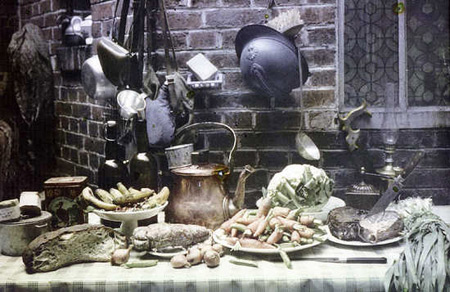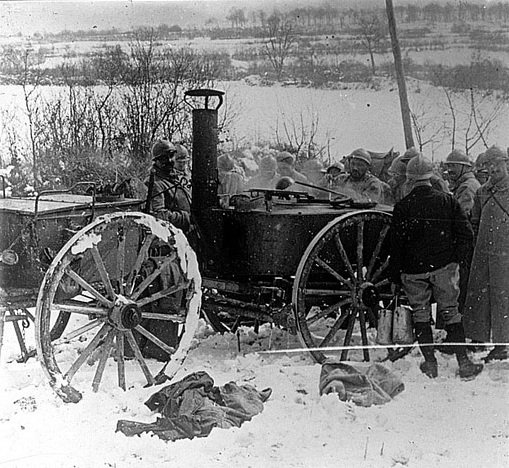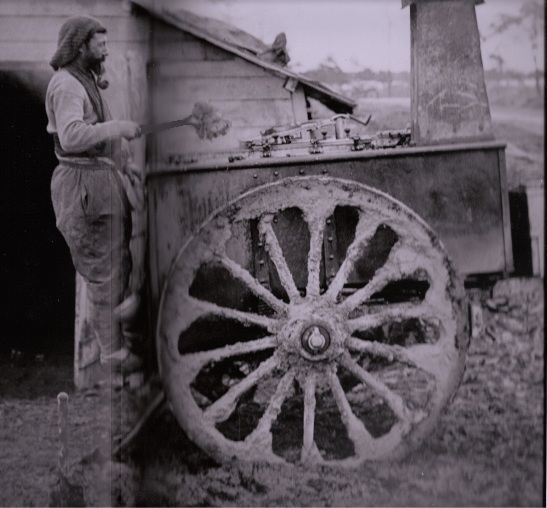Food Preparation

The importance of food and drink on the morale of soldiers was monumental. A warm meal along with a cup of wine or coffee had the ability to lift up the spirits of men worn down by war. Even the État-Major understood this simple fact. Compared to today's standards, the notion of what constituted a nutritious diet, particularly for men actively engaged in hard manual labor and strenuous combat, was somewhat different. Though distribution amounts for certain foods would change during the course of the war, the diet for the average poilu remained relatively unchanged throughout.
Meals
While in the field, there were only two meals a day: breakfast and dinner. Normally the men ate breakfast around 9 or 10:00 am, with the NCOs eating after this, and the officers last. Dinner was typically eaten around 5:00 pm, which often consisted of the left-over breakfast. Of course these time-tables were not always followed. André Pézard commented that: “We adopted the old habit of eating whenever we were able in case we couldn’t eat when we wanted to.” On some occasions, the men would receive only one large meal in the morning, eating only half of the portion at the time and reserving the other half in their mess-kits to eat later. Supplementing these meals was a pre-breakfast snack referred to by the acronym, P.D.D.M. (Petit Déjeuner Du Matin or "Morning Breakfast"). It consist solely of bread and coffee, and sometimes wine. Once the meal arrived, the corporals would oversee its distribution to the men of his squad.
Any left-overs, be it in the form of coffee, wine, or cheese, was known as the rabiot, or rab for short. If any rab could be scraped together, it would be shared out among those present. The trench newspaper “Marmita” explained in December 1915: “When on a foggy winter morning the corporal – the hot coffee distributed, consumed, causing almost a certain degree of regret for having drank it too quickly – cries out “au rabiot” to his Poilus, who each come up to his cup to grab a little extra ration, ah! Left-overs are good…” Gabriel Franconi echoed this: “The art of the corporal is the ability to divide a tin of sardines into fifteen equal portions and still have some left over. Left-overs from left-overs [rab de rab] . . . make it seem as if there’s a limitless amount; an army needs it to keep up morale.
The act of scrounging up left-overs was called “left-overing” (rabioter), in yet another application of the celebrated Système ‘D’. Often any left-overs that were on-hand was a simple matter of chance. But on other occasions extra food was appropriated in less honorable ways, by surreptitiously lifting food items from the Quarter-Masters or field kitchens. Those who were regular practitioners in this dubious art were called rabioteurs. They were looked upon with great admiration by those men fortunate enough to call them comrades, for any bounty requisitioned would be shared generously among the rabioteurs’ friends. Indeed, the most accomplished of the rabioteurs were elevated to something of the level of folk heroes, though among officers they were nothing more than brigands. Early in the war, the food supplied by the Intendance (“Quarter-Master”) had to be supplemented by food purchased locally and every company received a small sum of money for the purpose. As the war went on, this practice fell off. But it was not just how food was procured that changed but how it was prepared.
Field Kitchens
At the start of the war, this was done in the way it had in peacetime. Each infantry squad was responsible for preparing its own meals and the various squad cooking implements (boilers, mess-pans, canvas buckets and coffee grinder) were provided for this purpose and carried by the men on their own packs. In that way, each squad formed its own independent mess group as they had since times past. The squad's rations were distributed by squad (or platoon) by a corporal, who was responsible for dividing up the platoons rations out fairly. When there were insufficient rations in the supply train, men were sent out to purchase food from local townspeople. At other times, especially when encountering abandoned countryside and villages, the men simply foraged what they could, including meats, vegetables, dairy, and livestock. Rotating cook positions were assigned within the squad or section. Often, the cooks (nicknamed cuistots) were selected among those considered the worst soldiers and the poor shots in the company, though this was not always the case. Ultimately, two men from each squad were needed for the duty. La cuisine (“field kitchen”), more colloquially known as la cuistance or la popote ("mess"), was set up as close to the fighting line as possible. During the opening phases of the war, this was relatively close; anywhere from 400-800 meters away. The location of the field kitchen was chosen in a sheltered spot, protected from the elements and whenever possible near a water source. When circumstances called for it, the men would be distributed their ration directly and cook it themselves, the beef either roasted directly over the fire or grilled in a plat-a-quatre, while potatoes might be thrown directly onto the coals to roast.
There were several official ways to set up the cooking-fire according to the various army manuals. Perhaps the simplest and most convenient was to place two or four large stones close together around the fire-pit. The stew-pots were then rested on top of these and over the flames. In place of stones, a simple trench could be dug into the ground with the stew-pots resting on the edges. This type of set-up was used when the kitchen was only temporary, remaining in this spot for a few hours or perhaps one day. For longer stays, soldiers constructed a more lasting emplacement. A cross-shaped trench was dug, not too wide so as to allow the stew-pots to sit on top as before. Ideally, the two trenches were aligned with the cardinal directions to enhance draughting. A chimney was erected at the center, where the two trenches (fire-pits) met using sod, clumps of earth or stones. If possible, the cooking-pit was completed by placing two or three empty ration cans into the chimney. The stew-pots were set on top of the small entrenchments. Bricks could also be used to reinforce and improve the hearth. This style of cooking-fire allows for a proper draft whatever the direction of the wind. Additionally, it's possible to burn green or wet wood and even [earthen] coal by installing an improvised grill. An entire section can establish it's kitchen this way, which requires only one or two men to watch over it (an important advantage on rainy or heavy work days). Often the cooks constructed a light shelter made of wattling or tenet canvases to get them out of the sun and rain. If the ground was wet or if it were a rainy or windy day, the cooks would prepare the fire inside a large pot place the stoking paper or straw inside a large pot and lit, with a pile of dry sticks placed nearby. After having taken care to place in front of the fire-pit the most flammable sticks. The cook-pits, as much as possible, establish at a certain distance from walls in order to not cause any deterioration.

When a unit was in the fighting line or assigned to the advanced posts, the cuistots would be sent back at nightfall to fetch rations, start a fire and cook up the meal. Before daybreak, they would return to their squad with the prepared meal. Thus, more than thirty men per company would be occupied in the task, relying on half as many cooking fires. This would be repeated in the afternoon, conditions permitting, so that dinner could be prepared. It was a practical small army of cuistots who twice a day were absent from the firing line. As the front stabilized in the winter of 1914-15, the number of incidents of field kitchens being fired upon by the enemy’s artillery (the smoke and light of the fire often marked them as targets), forcing the kitchens to be placed in the second or third lines 1-3 km away. This made the round-trip between the kitchen and the front lines a small journey of its own. Though the number of cooks and cooking fires would be reduced through consolidation to twenty-five and nine respectively in early 1915, commanders still believed too many men were occupied in the duty and for too long a duration. In the spring of 1915, cooks were delegated to prepare the meals for the entire platoon.
Gradually the cuistots were provided with large cauldrons and boilers more suited for preparing large portions at a single time and the squad cooking implements were relegated simply as the means of transporting the rations from the kitchens up to the forward positions. As such, the infantryman continued to carry the cumbersome implements throughout the entire war. In order to reduce deforestation occurring around the field kitchens, a wood supply was introduced, which was supervised in rear areas by the Intendance. Fountains were also installed near water sources, which again allowed for a reduction in the number of hands needed for kitchen duty. By the summer of 1915, only sixteen men per company, supervised by a corporal, were designated as cooks with the number of cooking fires reduced to three and the number of boilers to six. Thus by the end of 1915, cooking had become a permanent job assigned to a small group of men.
Rolling Kitchens
The one factor that permitted the great reduction of the kitchen staff came with the introduction of a single instrument: the mobile field kitchen. While some units had benefited from these since 1914, their provision and employment became widespread only at the start of the new year. Beginning in February 1915, cuisines roulantes (“rolling kitchens”) were gradually provided to each company. By the fall of 1915, they became the dominant way of preparing the troops’ meals. Referred to simply as roulantes ("rollers”) their incontestable advantage over cooking fires theoretically rendered the boilers and cauldrons previously distributed superfluous. Rollers were basically boilers on wagons. Several different models were produced, all of which were four-wheeled and drawn by horse. Each was equipped with a fire-box that could burn either charcoal or wood and multiple cooking chambers which contained large cooking pots (removable for cleaning) totaling about 90 gallons in volume. Some models also included a separate 18-gallon stew pot strictly intended for brewing coffee. Meals could now be prepared even while on the move by one or two servers with ease, providing an incontestable advantage over open air cooking fires. With the introduction of the rollers, operations were even further centralized and the number of personnel needed for cooking was reduced to its lowest level – generally five or six men and one corporal.





